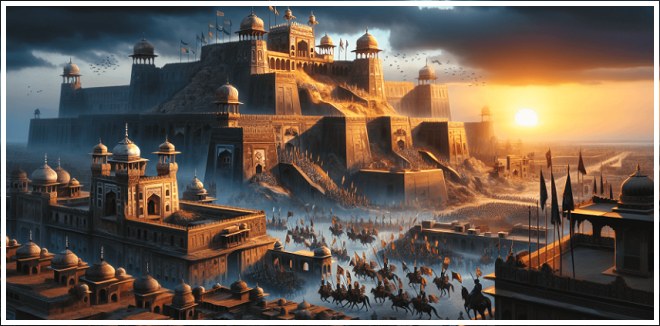Ahmad Shah Bahadur: The Fall of a Mughal Emperor
The Mughal Empire, once a beacon of power and grandeur in South Asia, witnessed a rapid decline during the reign of Ahmad Shah Bahadur. His tenure as emperor, from 1748 to 1754, is often described as a tumultuous period marked by internal conflicts, military defeats, and the disintegration of centralized authority. Despite his royal lineage, Ahmad Shah Bahadur’s reign was overshadowed by political intrigue and foreign invasions, leaving behind a legacy that underscores the challenges of leadership during a time of crisis.

Early Life of Ahmad Shah Bahadur
Born on December 23, 1725, Ahmad Shah Bahadur grew up in the splendor of the Mughal court. As the son of Emperor Muhammad Shah, he had access to education, culture, and resources that befitted a future ruler. However, his upbringing, focused more on the luxuries of palace life than the harsh realities of governance, left him ill-prepared for the throne.
Ahmad Shah Bahadur was known for his interest in art and poetry, but his lack of exposure to military training and administrative matters became a significant weakness. His sheltered life would later prove to be a disadvantage when he faced the immense challenges of ruling a fragmented empire.
Ahmad Shah Abdali’s First Invasion of India
One of the first crises Ahmad Shah Bahadur faced as emperor was the invasion of India by Ahmad Shah Abdali in 1748. Abdali, a former general of Nadir Shah, sought to exploit the weakened Mughal state. The invasion culminated in the Battle of Manupur, where Mughal forces, under the command of Safdarjung and Mir Mannu, managed to repel Abdali’s army. This victory was short-lived, as it merely delayed Abdali’s ambitions, setting the stage for future invasions that would devastate the Mughal Empire.

The Struggle for Succession
The death of Muhammad Shah in 1748 left the Mughal throne vulnerable to political manipulation. Ahmad Shah Bahadur ascended the throne amidst an environment rife with factionalism. The power struggle among nobles such as Safdarjung, Imad-ul-Mulk, and Javed Khan eroded the emperor’s authority. Ahmad Shah Bahadur’s inability to assert control over his court became a recurring theme throughout his reign.
Military Innovations During Ahmad Shah Bahadur’s Reign
Ahmad Shah Bahadur’s advisors attempted to modernize the Mughal military to address the growing threats from regional powers like the Marathas and foreign entities such as the British and French. New artillery units were introduced, and efforts were made to strengthen the cavalry. However, these innovations failed to compensate for the lack of discipline and leadership within the Mughal Army. The fragmented nature of the empire made it difficult to implement these reforms effectively.
Internal Transgressions (1750–1754)
Ahmad Shah Bahadur’s reign was characterized by internal conflicts and mismanagement. Corruption was rampant in his court, and many nobles prioritized personal enrichment over the welfare of the state. This lack of cohesion weakened the empire’s ability to respond to external threats, leaving it vulnerable to invasions and rebellions.

Salabat Khan’s Imprisonment
One of the key events during Ahmad Shah Bahadur’s reign was the imprisonment of Salabat Khan, a prominent military leader. This decision caused widespread discontent within the Mughal Army, leading to a decline in morale and effectiveness. The absence of competent leadership further eroded the empire’s ability to maintain order and defend its territories.
Safdarjung’s Campaign in Rohilkhand
Safdarjung, the Nawab of Oudh, emerged as a key figure during Ahmad Shah Bahadur’s reign. His campaign against Javed Khan’s allies in Rohilkhand was an attempt to consolidate power in the region. While the campaign achieved some success, it drained the empire’s resources and highlighted the growing autonomy of regional governors.
Ahmad Shah Bahadur and the Maratha Empire
The Maratha Empire, under leaders like Balaji Baji Rao, posed a significant threat to the Mughal Empire during Ahmad Shah Bahadur’s reign. The Marathas’ military prowess and organizational skills far outmatched those of the Mughals, leading to repeated defeats. The Mughal campaign against the Marathas ended in disaster, further diminishing the emperor’s credibility.
The Maratha Protectorate
By the mid-18th century, the Marathas had established a protectorate over much of northern India. Ahmad Shah Bahadur’s inability to counter their advances marked a turning point in the decline of Mughal power. The emperor became increasingly reliant on regional governors, who often pursued their own interests rather than those of the empire.
Imad-ul-Mulk and Court Intrigue
Imad-ul-Mulk, a powerful noble, played a crucial role in the political dynamics of Ahmad Shah Bahadur’s court. Initially a supporter of the emperor, he later allied with the Marathas to secure his position. This betrayal underscored the fragmented nature of the Mughal administration and Ahmad Shah’s inability to command loyalty among his advisors.
Defeat at Sikandarabad
The defeat of Mughal forces at Sikandarabad was a significant blow to the empire. The battle revealed the weaknesses of the Mughal military, including poor coordination and low morale. Ahmad Shah Bahadur’s inability to rally his forces highlighted his inadequacies as a leader.

Fragmented Polities of the Mughal Empire
During Ahmad Shah Bahadur’s reign, the Mughal Empire was divided into semi-autonomous regions controlled by nawabs and governors. These fragmented polities operated independently, undermining the emperor’s authority. This decentralization made it nearly impossible to implement policies or maintain order across the empire.
The First Carnatic War (1746–1748)
Although Ahmad Shah Bahadur was not directly involved in the First Carnatic War, the conflict between the British and French in southern India had implications for the Mughal Empire. The growing influence of European powers highlighted the declining relevance of the Mughals in Indian politics.
The Loss of Gujarat and Orissa
During Ahmad Shah Bahadur’s reign, the Maratha Confederacy captured Gujarat and Orissa, two of the empire’s most prosperous regions. These territorial losses severely impacted the Mughal economy and further diminished the emperor’s authority.
Ahmad Shah Abdali’s Subsequent Invasions
Ahmad Shah Abdali’s second and third invasions of India during Ahmad Shah Bahadur’s reign caused widespread devastation. The invasions not only resulted in significant territorial losses but also drained the Mughal treasury. Abdali’s incursions further weakened the empire’s central authority, accelerating its decline.

The French-Nizam Alliance
The French-Nizam alliance in the Deccan posed a new challenge to the Mughal Empire. The Nizam’s collaboration with the French highlighted the growing influence of European powers and the diminishing role of the Mughals in regional politics.
Death and Legacy
Ahmad Shah Bahadur’s reign came to an end in 1754 when he was deposed by his successor, Alamgir II. He spent the remainder of his life in captivity, dying in obscurity. His legacy is a sobering reminder of the challenges faced by the Mughal Empire during its decline. While his reign was marked by failures, it also reflected the broader structural issues that plagued the empire.
Conclusion
Ahmad Shah Bahadur’s story is one of unfulfilled potential and missed opportunities. His reign highlights the complexities of leadership during a period of decline and the impact of internal divisions and external threats on the Mughal Empire. Despite his shortcomings, his life offers valuable lessons about governance, resilience, and the importance of strong leadership in times of crisis
Family of Ahmad Shah Bahadur
Sons
Ahmad Shah Bahadur is believed to have had multiple sons, though historical records do not provide precise details about their names, birthdates, or contributions. Royal sons in the Mughal dynasty were often groomed for administrative roles, but during Ahmad Shah’s reign, his sons did not play significant public roles.
Daughters
Similar to his sons, there is limited documentation about Ahmad Shah Bahadur’s daughters. Mughal daughters often lived within the confines of royal traditions, engaging in cultural patronage but staying away from political affairs unless specifically noted in historical texts.
Wives
Ahmad Shah Bahadur, like most Mughal emperors, had several wives, many of whom were married to secure political alliances. His chief consort was Udham Bai, who wielded significant influence in the court. However, records about his other wives are sparse, as they did not play major roles in the empire’s politics.
Ahmad Shah Bahadur, like many Mughal emperors, had several wives, but the exact number of his spouses and detailed records about their lives are not well-documented in historical accounts. The Mughal court’s traditions often kept detailed genealogies of male heirs but paid comparatively less attention to the emperor’s wives unless they held significant political influence.
General Information:
Birth: Ahmad Shah Bahadur was born on December 23, 1725.
Reign: He ascended the throne in 1748 and ruled until his deposition in 1754.
Death: Ahmad Shah Bahadur died on January 1, 1775, after living in captivity for many years.
Details about his wives and their roles remain obscure, but royal Mughal marriages were typically arranged for political alliances, and many wives might not have had prominent public roles.










